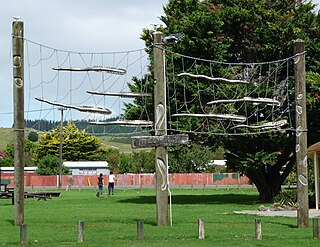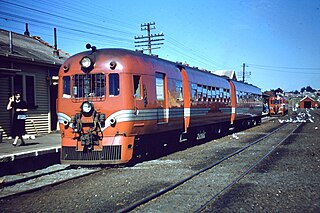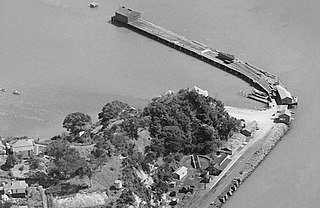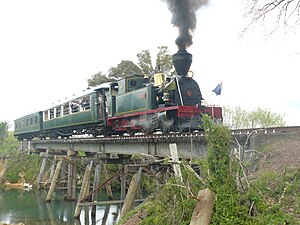
Railway preservation in New Zealand is the preservation of historically significant facets of New Zealand's rail transport history. The earliest recorded preservation attempt took place in 1925, although the movement itself did not start properly until 1960.

Rail transport in New Zealand is an integral part of New Zealand's transport network, with a nationwide network of 4,375.5 km (2,718.8 mi) of track linking most major cities in the North and South Islands, connected by inter-island rail and road ferries. Rail transport in New Zealand has a particular focus on bulk freight exports and imports, with 19 million net tonnes moved by rail annually, accounting for more than half of rail revenue.

Kawakawa is a small town in the Bay of Islands area of the Northland Region of New Zealand. Kawakawa developed as a service town when coal was found there in the 1860s, but coal mining ceased in the early 20th century. The economy is now based on farming. The town is named after the kawakawa shrub.

Moerewa is a small town in the Northland Region of the North Island of New Zealand. It is located close to the Bay of Islands five kilometres to the west of Kawakawa.

The Dargaville Branch is a branch line railway that leaves the North Auckland Line not far south of Whangarei and runs westward to Dargaville. Construction of this relatively short line took approximately two decades, and when it was completed, it linked the now closed Donnellys Crossing Section with the national rail network. The branch has been closed to all traffic since 2014 and is currently used by a tourist railcart operation.

The North Auckland Line is a major section of New Zealand's national rail network, and is made up of the following parts: the portion of track that runs northward from Westfield Junction to Newmarket Station; from there, westward to Waitakere; from there, northward to Otiria via Whangārei. The first section was opened in 1868 and the line was completed in 1925. The line, or sections of it, have been known at various times as the Kaipara Line, the Waikato-Kaipara Line, the Kaipara Branch and the North Auckland Main Trunk.

The Okaihau Branch, sometimes known as the Kaikohe Branch and rarely the Rangiahua Branch, was a branch line railway that joined the North Auckland Line of the national rail network of New Zealand at Otiria. It was the most northerly line in New Zealand and was intended to run all the way to Kaitaia. It opened to Ōkaihau in 1923 and closed in 1987.
The Opua Branch or Otiria-Opua Industrial Line, partially still operational as the Bay of Islands Vintage Railway, is a former section of the North Auckland Line in the Northland Region of New Zealand, between Otiria and the Bay of Islands township of Opua. The first section was constructed as a bush tramway in 1868 and converted to a railway in the next decade. Today the railway is partially used by the Bay of Islands Vintage Railway, which runs tourist services between Kawakawa and Lone Cow. The line's centrepiece is the section where it runs down along the main street of Kawakawa.

The NZR RM class 88-seaters were a class of railcar used in New Zealand. New Zealand Government Railways (NZR) classified them as RM (Rail Motor), the notation used for all railcars, numbering the 35 sets from RM100 to RM134. They were the most numerous railcars in NZR service. Their purchase and introduction saw the demise of steam-hauled provincial passenger trains and mixed trains, and was part of a deliberate effort to modernise NZR passenger services at a time of increasing competition from private motor vehicles. Being diesel powered and lighter the railcars were less expensive to operate and able to maintain quicker timetables, although became plagued with mechanical and electrical problems, with a number of the class eventually being turned into depowered locomotive-hauled carriages and reclassified as the AC class "Grassgrubs".

The Railway Enthusiasts Society Incorporated is a New Zealand railway enthusiast society formed on 17 July 1958. RES formed the Glenbrook Vintage Railway (GVR) in 1968, with GVR now forming a separate charitable trust.

The New Zealand DA class locomotive were a class of diesel-electric mainline locomotives operated on the New Zealand railway system between 1955 and 1989. Consisting of 146 locomotives, it was the most numerous class to ever operate in New Zealand, with five more than the AB class steam locomotive.

The New Zealand DE class was a class of fifteen diesel-electric shunting locomotives, introduced by the New Zealand Railways (NZR) with an intention to replace steam locomotives on shunting duties with diesel power. The class was physically similar to the Tasmanian Government Railways X class, which was also of English Electric design.

Opua is a locality in the Bay of Islands, in the sub-tropical Northland Region of New Zealand. It is notable as the first port for overseas yachts arriving in the country after crossing the Pacific Ocean. In the original 1870s plans for the town, it was named Newport. The town of Paihia is nearby, and the small settlement of Te Haumi is in between.

Steam Incorporated, often abbreviated to Steam Inc., is a railway heritage and preservation society based at the Paekākāriki railway station, Paekākāriki at the southern end of the Kāpiti Coast, approximately 50 minutes north of Wellington on the west coast of New Zealand's North Island. Unlike some societies who operate on preserved sections of closed branch lines, Steam Incorporated owns a depot beside one of the country's most important railway lines, the North Island Main Trunk railway, and restores heritage locomotives and rolling stock for use on excursions on the regular national rail network.
Taumarere is a locality in the Bay of Islands in Northland, New Zealand. The Kawakawa River and State Highway 11 run through Taumarere. The town of Kawakawa is 3 km to the southwest. Opua is 7 km to the north and Paihia 14 km.

Otiria is a rural locality in the Northland Region of New Zealand's North Island. It neighbours Moerewa to the east, with the nearest major town, Kawakawa a few kilometres further eastwards. Other nearby localities include Pokapu to the south, Orauta to the west, and Hupara to the north.

The Kawakawa River is in the Northland Region of New Zealand's North Island. It flows predominantly eastward to Opua, where it joins the Waikare Inlet to flow into the Veronica Channel at the southern end of the Bay of Islands.

Opua railway station was a station on the Opua Branch in New Zealand, serving the port of Opua.

Te Akeake railway station, is a station on the Opua Branch in New Zealand.



















